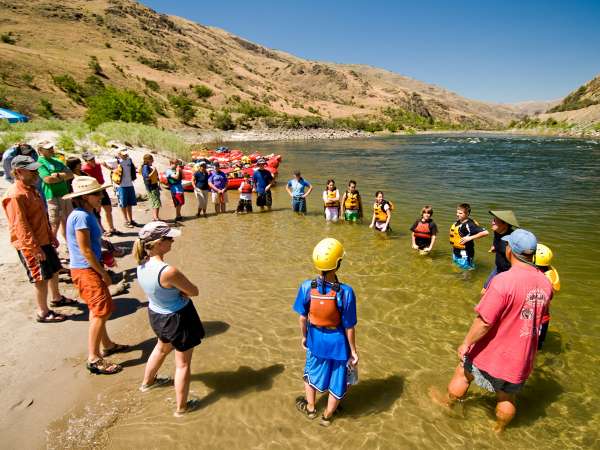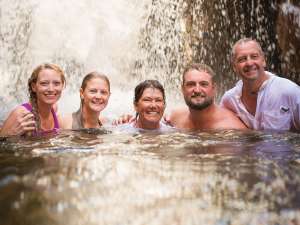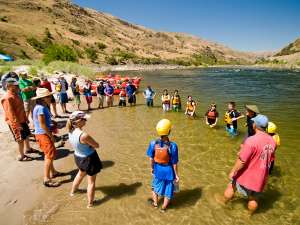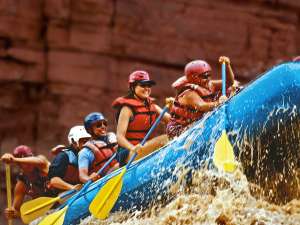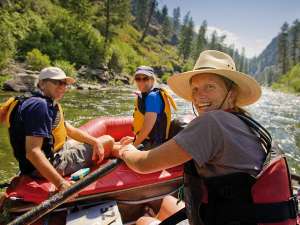Is rafting dangerous?
Rafting is thrilling, exciting, wet, wild and unbelievably fun. However, as with all adventure sports, there is inherent risk involved. That risk contributes to the excitement, and is one of the reasons people enjoy rafting so much. The guides working for the outfitters promoted by Rafting America are trained to minimize and manage risks, and, statistically, you’re safer in a raft than in your car. One government report noted that the injury rate for whitewater rafting is similar to that for bowling! The most common injury on most rafting trips is sunburn, and most other injuries occur on land, especially getting into and out of the boats.
I can't swim. Can I still go rafting?
Everyone on commercial rafting trips wears a coast guard approved life vest or personal flotation device (PFD). This critical piece of equipment will keep you afloat in the event that you find yourself in the river. Many non-swimmers go on rafting trips, and they have a great time. Your guide will give you an in depth safety talk before your trip explaining what you should prepare for and do in the event you fall out of the raft. Your guide is professionally trained in whitewater rescue and will work with the rest of your guide team to ensure that you are able to feel comfortable with the whitewater conditions on your trip. All non-swimmers should talk to their outfitter when considering a Class IV+ or Class V trip.
How fit should I be to go rafting? Is it strenuous?
On rafting trips where we use oar boats (the guide does most of the work), you can choose to be as active as you wish. On many rafting trips paddle boats are used. This means that guests will be an active source of power to move the boat through the rapids and you will need to learn commands from your guides to help maneuver the boat as it moves downstream. You should be reasonably healthy, and must be able to fit into the life vests supplied by your outfitter. Paddling can sometimes be tiring, but your guides will instruct you on paddling techniques which are lots of fun to learn. If you’re in doubt about your fitness to go rafting, check with your doctor before you go.
What should I wear on the river?
Luckily…this is not a fashion contest! Your gear will depend on the time of year, water temperature, and weather for your trip. Ask your outfitter for gear recommendations before your trip. As a rule of thumb we recommend you dress for the water temperature, rather than the air temperature, since you’ll be getting wet. Wetsuits can be rented with many outfitters, and are best when you know you’ll be constantly wet–some rivers have prolonged spaces between rapids, which can make a wetsuit unbearable in hotter temps. Cooler days, with cold water, and especially Class V trips, we require a wetsuit, or a wetsuit/paddle jacket combination. You might also bring some synthetic fleece, polypro, capilene, or wool garments. Don’t wear cotton because when it becomes wet, it will just make you colder. An old pair of tennis shoes, running shoes, or even Converse hi-tops are the best on the river. Wetsuit booties are good if it is cold. Sandals don’t offer as much protection, and tend to come off easily in a swim. Sunglasses, especially prescription glasses, should have a croakie or other retainer that cinches tight. Consider a hat cord to tie your hat to your life jacket as well. In warmer weather, and late season warmer water, shorts and a T-shirt are good. Use sunscreen, but don’t put it on your forehead, or the backs of your legs. It may run into your eyes, or cause you to be slipping all over the boat.
I've never been before. Which trips are best for me?
If you are just learning to raft, start off with a Class II or III, or an easy Class IV rafting trip. If you are nervous about being part of a paddleboat, an alternative is to ride along on an oar boat, which many companies offer on different rivers. Many rafters who are confident in the water, healthy, and feel adventurous, drop right into a Class IV river without prior experience. Guides will make sure you are trained in safety and paddle techniques. For Class V rivers, you must have prior class IV experience. Some outfitters that operate on larger whitewater, such as the Colorado River, offer motorized rigs large enough to provide a variety of intensity depending on where you sit on the boat.
I have a family with young children. Can they go rafting?
Many companies have special family trips available, on which you can take children as young as four. Each particular river trip and company has its own suggested age limits. Generally speaking, the smallest Coast Guard approved youth lifejackets typically fit a 5 year old child, and thus 5 yrs tends to be the common minimum age limit. Contact the individual outfitters to find out suggested ages for their trips. You might start by looking at the trips listed on the “Families” page.
I am a senior citizen. Can I go rafting?
For fit, active seniors over 65 we recommend, as a first step, a class II paddleboat or oar boat trip. Depending on how this feels to you, you might want to try paddling a Class III river. Many healthy people of all ages, including spry folks in their 70’s and 80’s enjoy rafting at all levels.
What happens on a typical rafting trip?
Your trip begins when you meet the trip leader at your designated rendezvous place and time. He or she will collect your release forms and distribute wetsuits (if needed) from your outfitter. Then everyone gets on the bus which will transport you to the “put in” where rafts await you in the river. At the put in, the trip leader will give you a safety talk – a vital 20 to 30 minute discussion about how to be safe on the water. Then you’ll head to your boat and jump in! Paddleboats typically seat six to eight people and a guide. On a paddleboat, the guide will give you further instruction on how to paddle once you are afloat and give you time to practice following his or her commands. Then you’ll head on down the river, and have the time of your life! There are some unique boat designs, including virtually unflippable, large motorized pontoon rafts used in the Grand Canyon, that allow seating options to match the level of adventure desired.
What are my chances of falling out of the boat? What if Ido?
Plan “A” is always to stay in the boat, but believe it or not, many people love falling out of the boat. It’s exciting. But it can be disorienting and a little overwhelming at first. Many people have taken multiple trips and never fallen in. Paying attention to what is happening around you, and digging in with your paddle or grip of the rope are obviously key factors to staying with the boat. Some people swim on their first trip. It’s all a part of rafting. Before you go on any trip, you’ll be given extensive instructions on what to do if you fall in, and how to stay safe. Be sure to have a securely fastened life vest, follow your guide’s instructions for swimming techniques, and your “swim” could be the most exciting part of your trip and a great story to tell your friends afterwards!
Can i bring my camera or video camera?
We don’t recommend bringing video cameras, or even expensive still cameras, on trips. Many people bring disposable waterproof cameras, which work just fine. The quality of the pictures is reasonably good, and if you lose your disposable camera, it’s not the end of the world. There are several rugged and waterproof digital cameras on the market today that require no waterproof case. If you do choose to bring a more expensive camera, you can protect it with waterproof cases available in the retail market that fit many shapes and sizes of camera. Many river trips also have professional photographers riverside, whose photos you can view and order after the trip.
Should I tip my guide?
Tipping is certainly appreciated by the guides, who work hard to make sure you have a fun, yet safe trip. If you feel your guide has done a good job, keeping you entertained, and sharing the wonderful river environment with you, then feel free to show your appreciation.

